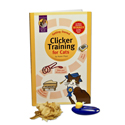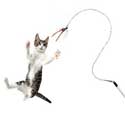Q: I've gotten my niece onto clicker training with her family cat. I told her about the training game and we tried it out on each other a few times, although I may not be remembering all of the rules. My niece has been doing the training game with her sister, but I gather they do it more like the game Hot & Cold. She (as trainer) became angry with me (as animal) when I moved too fast and wouldn't move my arms (she wanted me to flap my arms). I tried to explain successive approximation and told her that *I* have much trouble with my timing of the clicks and thinking of ways to reinforce Cica (my cat) to get her to do a certain behavior. She thought I wasn't playing fair. She also didn't understand my saying that it's not up to the "animal" to figure out and guess what the trainer wants. Can you tell us more about the rules of this game? I love having a way to talk with my cat.
A: The Training Game is a great way to sharpen your shaping skills and have fun at the same time. It allows you to see and experience other trainers' decision points, and to be aware of what you might have done instead. It also allows trainers to make mistakes, and learn from them, without confusing some poor animal or unsuspecting person! Maybe most valuable of all, it allows you to see the training process from the viewpoint of the trainee, which is often a highly illuminating experience. The training game also helps us get rid of the superstitious behavior of putting the blame for problems on the person or animal we are working with, instead of on the training contingencies, where it belongs. Click here for more to learn how to play.
You might also be interested in "You don't say!" —our new, word-free teaching and training game.








Post new comment